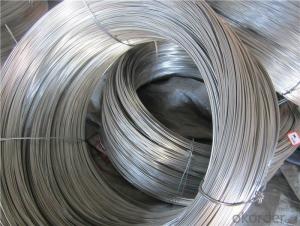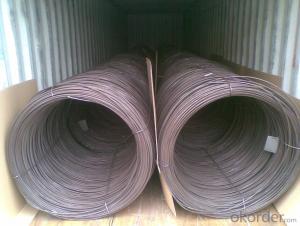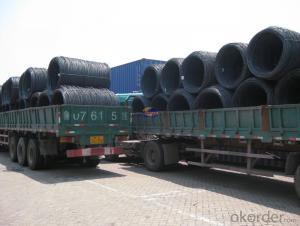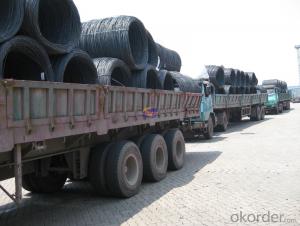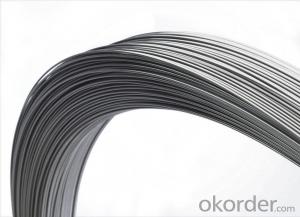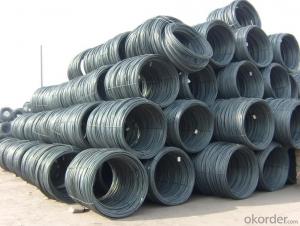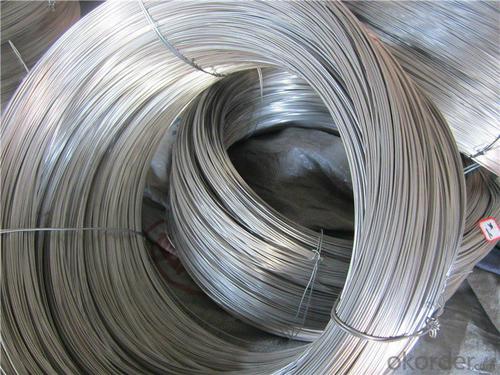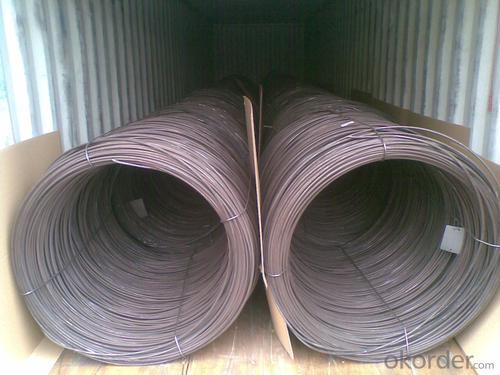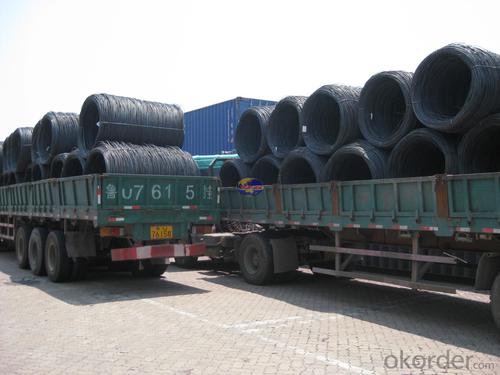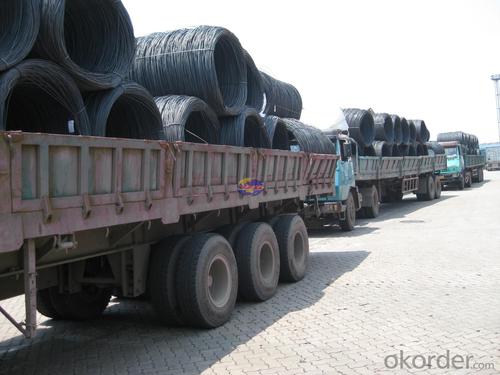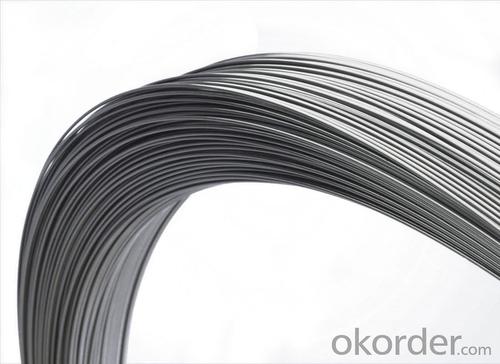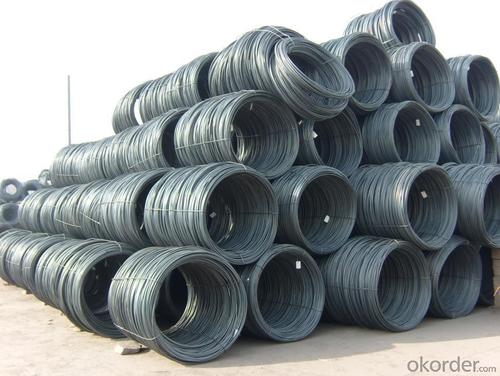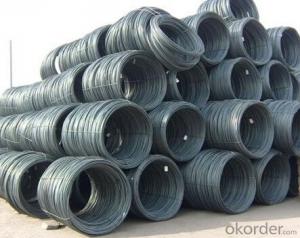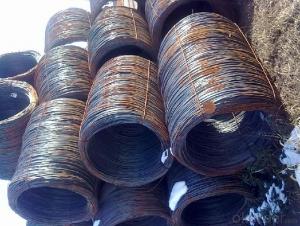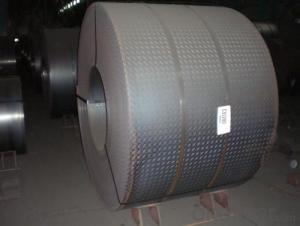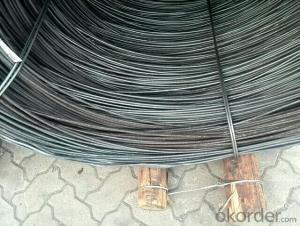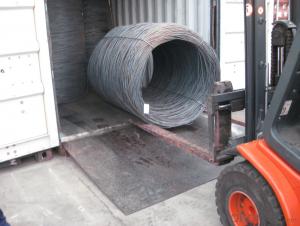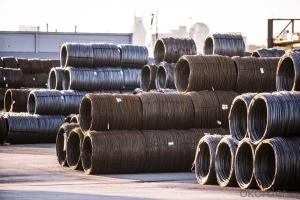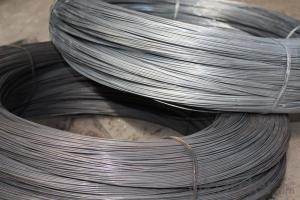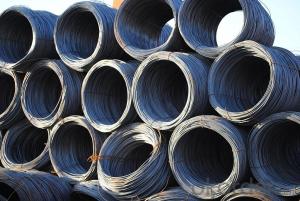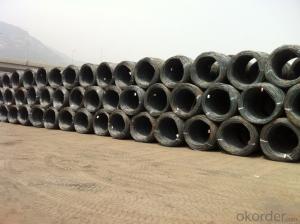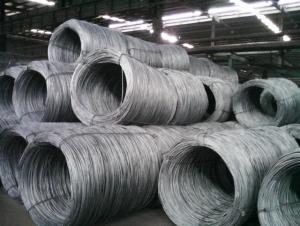SAE1006Cr Carbon Steel Wire Rod 17mm for Welding
- Loading Port:
- Shanghai
- Payment Terms:
- TT OR LC
- Min Order Qty:
- 100 m.t
- Supply Capability:
- 30000 m.t/month
OKorder Service Pledge
OKorder Financial Service
You Might Also Like
Specification
Description of SAE1006Cr Carbon Steel Wire Rod 17mm for Welding:
OKorder is offering Color Coated Steel Coil Prepainted Steel Coil at great prices with worldwide shipping. Our supplier is a world-class manufacturer of steel, with our products utilized the world over. OKorder annually supplies products to European, North American and Asian markets. We provide quotations within 24 hours of receiving an inquiry and guarantee competitive prices.
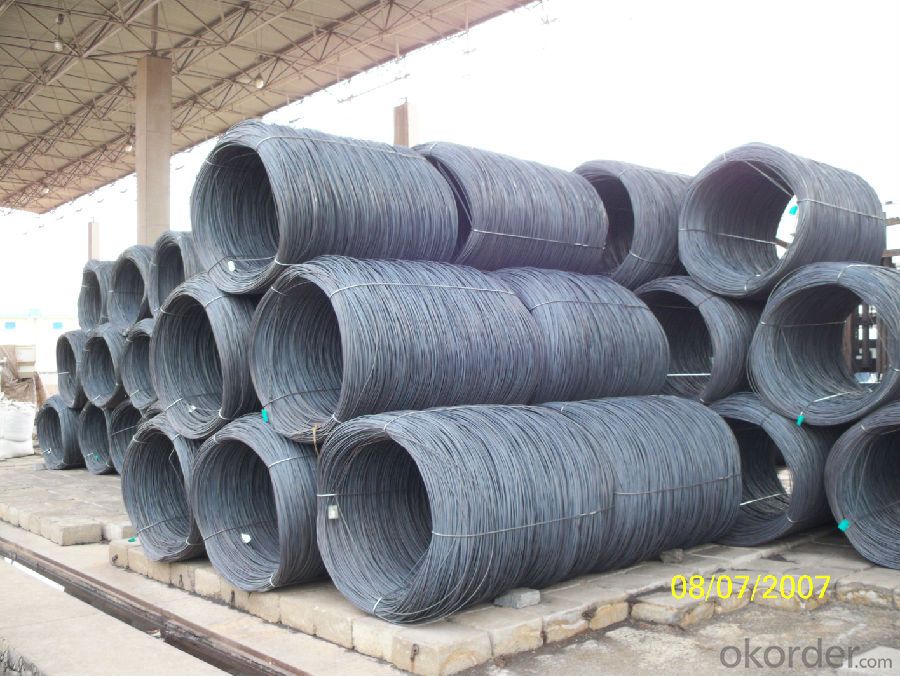
Applications of SAE1006Cr Carbon Steel Wire Rod 17mm for Welding:
Color Coated Steel Coil Prepainted Steel Coil are ideal for structural applications and are widely used in the construction of buildings and bridges, and the manufacturing, petrochemical, and transportation industries.
Main Product Features of SAE1006Cr Carbon Steel Wire Rod 17mm for Welding:
· Premium quality
· Prompt delivery & seaworthy packing (30 days after receiving deposit)
· Corrosion resistance
· Can be recycled and reused
· Mill test certification
· Professional Service
· Competitive pricing
Specifications of SAE1006Cr Carbon Steel Wire Rod 17mm for Welding:
1, Introduction: Color coated steel coils(sheets), i. E. PPGI, also called prepainted steel coils(sheets), are made of galvanized steel coils(sheets) with polymer coatings as surface. It's a new enclosure material and building board with characteristics of light-weighted, heat preserved&insulated, easily installed with bright colors.
2, Production Process: Pretreatment(Degreasing)_Drying_Chromating_Paint Basic Oil_Cooling_Drying_Color Coating_Cooling_Film-covering_Rolling Up
3, Characteristics:
Good at corrosion resistence. Besides zinc coating of the basic plate of galvanized steel sheet, the color coating as the surface has double lifetime to ensure better anticorrosion effect.
With excellent cold bending molded manufacturablity, PPGI products can be processed or directly used as final product. As being light-weighted and conveniently transported, they're widly used to replace wood to save energy.
4.There're thousands of colors can be chosen as per different application. Any color plays well in decoration.
No pollution with high recycling rate, PPGI coils and sheets are strongly recommended as enviroment-friendly products by the government.
5, eye bands and 4 circumferential bands in steel, galvanized metal fluted rings on inner and outer edges, galvanized.
| commodity | SAE1006Cr Carbon Steel Wire Rod 17mm for Welding |
| Techinical Standard: | JIS G3302-1998, EN10142/10137, ASTM A755 |
| grade | Q195,Q215,Q235,SAE1006,SAE1008 SAE1006Cr |
| Types: | Mesh welding |
| Base metal | galvanized, galvalume, cold rolled steel |
| Thickness | 0.14-1.0mm(0.16-0.8mm is the most advantage thickness) |
| Width | 610/724/820/914/1000/1200/1219/1220/1250mm |
| Type of coating: | PE, SMP, PVDF |
| Zinc coating | Z60-150g/m2 or AZ40-100g/m2 |
| Top painting: | 5 mic. Primer + 15 mc. R. M. P. |
| Back painting: | 5-7 mic. EP |
| Color: | According to RAL standard |
| ID coil | 508mm610mm |
| Coil weight: | 2--3MT |
| Package: | Properly packed for ocean freight exportation in 20'containers |
| Application: | Industrial panels, roofing and siding for painting/automobile |
| Price terms | FOB, CFR, CIF |
| Payment terms | 20%TT in advance+80% TT or irrevocable 80%L/C at sight |
| delivery time | 25 days after recepit of 20% TT |
| Remarks | Insurance is all risks |
| MTC 3.1 will be handed on with shipping documents | |
| We accept SGS certificatation test |
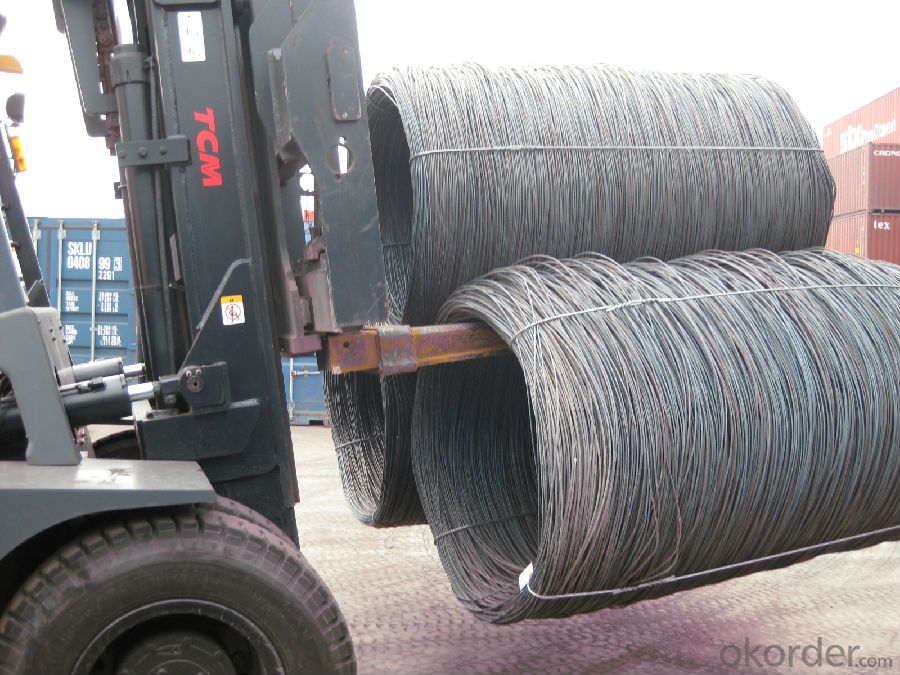
FAQ of SAE1006Cr Carbon Steel Wire Rod 17mm for Welding:
Q1: Why buy Materials & Equipment from OKorder.com?
A1: All products offered byOKorder.com are carefully selected from China's most reliable manufacturing enterprises. Through its ISO certifications, OKorder.com adheres to the highest standards and a commitment to supply chain safety and customer satisfaction.
Q2: How do we guarantee the quality of our products?
A2: We have established an advanced quality management system which conducts strict quality tests at every step, from raw materials to the final product. At the same time, we provide extensive follow-up service assurances as required.
Q3: How soon can we receive the product after purchase?
A3: Within three days of placing an order, we will begin production. The specific shipping date is dependent upon international and government factors, but is typically 7 to 10 workdays.
Q4: What makes stainless steel stainless?
A4: Stainless steel must contain at least 10.5 % chromium. It is this element that reacts with the oxygen in the air to form a complex chrome-oxide surface layer that is invisible but strong enough to prevent further oxygen from "staining" (rusting) the surface. Higher levels of chromium and the addition of other alloying elements such as nickel and molybdenum enhance this surface layer and improve the corrosion resistance of the stainless material.
Q5: Can stainless steel rust?
A5: Stainless does not "rust" as you think of regular steel rusting with a red oxide on the surface that flakes off. If you see red rust it is probably due to some iron particles that have contaminated the surface of the stainless steel and it is these iron particles that are rusting. Look at the source of the rusting and see if you can remove it from the surface.
- Q: How is the steel wire rod market affected by changes in trade policies?
- Changes in trade policies can have a significant impact on the steel wire rod market. Trade policies such as tariffs or quotas can influence the supply and demand dynamics, production costs, and competitiveness of steel wire rod producers. When trade policies impose tariffs on steel wire rod imports, it can increase the cost of importing the product, making it more expensive for domestic manufacturers to source raw materials. This can lead to an increase in the price of steel wire rod in the domestic market, affecting the profitability of manufacturers and potentially reducing the demand for the product. Conversely, if trade policies impose tariffs on steel wire rod exports, it can limit the market access for domestic manufacturers, reducing their ability to sell their products internationally and potentially impacting their revenue. Quotas on steel wire rod imports can also have a significant impact on the market. When quotas are imposed, it limits the quantity of imported steel wire rod that can enter the domestic market. This can lead to a decrease in supply, potentially creating a shortage in the market and driving up prices. On the other hand, if quotas are imposed on steel wire rod exports, it may restrict the ability of domestic manufacturers to access international markets, reducing their market reach and potentially affecting their profitability. Changes in trade policies can also impact the competitiveness of domestic steel wire rod producers. If trade policies favor domestic producers by imposing higher tariffs on imports, it can provide a competitive advantage to domestic manufacturers by making imported steel wire rod more expensive. This can incentivize domestic production and potentially lead to increased investment in the industry. Conversely, if trade policies favor imports by imposing higher tariffs on exports, it can hinder the competitiveness of domestic producers, making it difficult for them to compete in international markets. Overall, changes in trade policies can have both positive and negative impacts on the steel wire rod market. The extent of these impacts depends on the specific trade policies implemented and the reactions of market participants.
- Q: How is steel wire rod used in the production of wire fencing?
- Wire fencing production relies on steel wire rod as its main raw material. The rod goes through a series of steps, such as drawing, galvanizing, and coating, to transform it into high-quality wire suitable for fencing. To begin, the steel wire rod is drawn through dies that reduce its diameter and increase its length. This process strengthens the wire, making it more durable and resistant to breakage. Afterward, the wire is galvanized by coating it with zinc. This galvanization protects against corrosion, ensuring the longevity of the wire fencing, even in harsh weather conditions. Following galvanization, the wire can undergo further processing to enhance its functionality for specific fencing purposes. For example, it can be coated with PVC to improve its resistance to moisture, UV rays, and other external factors. This not only adds an extra layer of protection but also increases visibility, making it suitable for security fencing or animal enclosures. Once the steel wire rod has been transformed and processed, it is used to manufacture various types of wire fencing. The wire can be woven or welded to create different designs and patterns, depending on the specific fencing project's requirements. It serves various applications, including agricultural, perimeter, construction, and decorative fencing. In conclusion, steel wire rod is vital in wire fencing production. It undergoes multiple processing steps to improve its strength, durability, and resistance to corrosion. The resulting wire is used to manufacture different types of fencing, providing security, protection, and containment for various applications.
- Q: How is steel wire rod used in the manufacturing of staples?
- Steel wire rods are an essential component in the manufacturing of staples. These wire rods are typically made from high-quality steel and are available in various diameters. The process of manufacturing staples begins with the steel wire rods being coiled and then drawn through a series of dies to reduce their diameter and increase their length. This drawing process not only enhances the strength of the wire but also ensures its uniformity. Once the desired wire diameter is achieved, the steel wire is cut into smaller lengths, which will determine the size of the staples being produced. These wire lengths are then fed into a specialized staple manufacturing machine, where they undergo a series of operations. Firstly, the wire is fed into a machine that straightens and cleans it to remove any impurities or irregularities. The straightened wire is then cut and shaped into individual staple blanks. These blanks are further processed using a combination of bending, cutting, and shaping operations to form the distinctive "U" shape of the staple legs. Next, the legs of the staples are clinched or bent inwards to create the necessary tension for them to hold papers or other materials together. This process is typically performed using a clinching machine, which applies the necessary force to bend the legs inward, creating the final staple shape. Finally, the manufactured staples undergo a quality control check to ensure that they meet the required standards in terms of dimensions, strength, and overall quality. This may involve checking for proper leg length, uniformity of shape, and testing the staples' ability to hold materials securely. In summary, steel wire rods play a crucial role in the manufacturing of staples by providing the high-strength material necessary for securely holding papers or other materials together. Through a series of processes, the wire rods are transformed into the distinctive "U" shape of staples, ensuring their functionality and reliability for various applications.
- Q: How is steel wire rod used in the manufacturing of wire for water filtration systems?
- Steel wire rod is an essential element in the production of wire used in water filtration systems. It serves as the initial material that undergoes various processes to create the wire for these systems. To begin, high-quality carbon or alloy steel is typically used to make the steel wire rod, ensuring that the final product is durable and strong. The rod then goes through a series of manufacturing steps, including hot rolling, cold drawing, and annealing. During the hot rolling process, the steel wire rod is heated and passed through rollers to decrease its diameter and increase its length. This step helps refine the internal structure of the steel and enhance its mechanical properties. Following this, the cold drawing process further reduces the diameter of the wire rod and improves its surface finish. This involves pulling the rod through dies, gradually reducing its size while enhancing its dimensional accuracy and surface quality. After the cold drawing process, the wire rod is typically annealed to relieve internal stresses and increase its ductility. Annealing entails heating the wire to a specific temperature and slowly cooling it down. This process enhances the wire's flexibility and makes it easier to work with during subsequent manufacturing stages. Once the steel wire rod has undergone hot rolling, cold drawing, and annealing, it is ready for the final steps in wire production. These involve shaping and coating the wire based on the specific requirements of the water filtration system. Depending on the design of the filtration system, the wire may be shaped into various forms like mesh, woven wire cloth, or spiral wound wire. It may also undergo a coating process, where materials such as PVC or polyethylene are applied to enhance corrosion resistance and prolong its lifespan. In summary, steel wire rod is a critical component in the production of wire for water filtration systems. Through a series of manufacturing processes, the rod is transformed into a highly functional wire that possesses the necessary strength, durability, and filtration capabilities required for efficient water purification.
- Q: How is steel wire rod used in the manufacturing of wire for overhead power lines?
- Steel wire rod is a crucial component in the manufacturing of wire for overhead power lines. It serves as the primary raw material in the production process. The first step involves melting down steel scrap or iron ore in a furnace to create molten steel. This molten steel is then continuously cast into billets or blooms, which are essentially large rectangular or round bars. The next step is rolling these billets or blooms into steel wire rod. This process usually takes place in a wire rod mill, where the billets or blooms are heated and passed through a series of rollers that gradually reduce their size and shape them into long, thin rods. These steel wire rods are typically hot-rolled, which means they are formed while the steel is still at a high temperature. The hot-rolling process gives the wire rod its desired strength and flexibility, making it suitable for use in overhead power lines. Once the steel wire rod is produced, it undergoes further processing to transform it into wire for overhead power lines. This involves a series of drawing operations, where the wire rod is pulled through a series of dies to gradually reduce its diameter and increase its length. This drawing process ensures that the wire achieves the required dimensions and mechanical properties. After the wire has been drawn to the desired specification, it is usually subjected to heat treatment to enhance its strength and durability. This heat treatment process, known as annealing, involves heating the wire to a specific temperature and then cooling it slowly to relieve internal stresses and improve its metallurgical properties. Finally, the wire is coated with a layer of protective material, such as zinc, to prevent corrosion and extend its lifespan. This coating process, known as galvanization, involves immersing the wire in a molten zinc bath or using an electroplating method to apply a zinc layer onto its surface. Overall, steel wire rod plays a critical role in the manufacturing of wire for overhead power lines. It provides the necessary raw material for the production process and undergoes various stages of rolling, drawing, heat treatment, and coating to transform it into a high-quality wire that can withstand the demanding conditions of power transmission.
- Q: What are the common production processes for nickel-coated steel wire rod?
- The common production processes for nickel-coated steel wire rod include cleaning the steel wire rod, applying a nickel coating through electroplating or electroless plating, and then undergoing additional processes such as annealing, drawing, and polishing to achieve the desired properties and surface finish.
- Q: How is steel wire rod used in the manufacturing of wire forms for packaging?
- Steel wire rod is an essential material used in the manufacturing of wire forms for packaging. It serves as the base material for creating various wire products that are widely used in packaging applications. One of the primary uses of steel wire rod in packaging is the production of wire baskets and racks. These wire forms are commonly used for storing and transporting goods, providing a sturdy and reliable solution for packaging needs. The steel wire rod is processed and shaped into different forms and sizes to create these wire baskets and racks, which are then used for organizing and protecting various packaged items. Additionally, steel wire rod is also utilized in the production of wire hooks and clips. These wire forms are often used to secure packaging materials, such as plastic bags or boxes, preventing them from opening or spilling their contents during transportation. The durability and strength of steel wire rod make it an ideal material for creating these hooks and clips, ensuring that packaging remains intact and secure. Moreover, steel wire rod is employed in the manufacturing of wire ties, also known as twist ties or bag closures. These wire forms are commonly used in the packaging industry to seal bags, bundles, or packages, providing a simple yet effective way to keep items tightly sealed and protected. The flexibility and malleability of steel wire rod allow for easy bending and shaping into twist ties, making it an essential component in their production. Overall, steel wire rod plays a crucial role in the manufacturing of wire forms for packaging. Its strength, durability, and versatility make it a preferred material for creating various wire products used in packaging applications, such as baskets, racks, hooks, clips, and twist ties. By utilizing steel wire rod, packaging solutions can be designed to withstand the rigors of transportation and ensure the safe and secure handling of goods.
- Q: How is steel wire rod recycled?
- Steel wire rod is typically recycled through a process called electric arc furnace (EAF) steelmaking. In this process, the steel wire rod is melted down in an electric arc furnace, where impurities are removed. Once purified, the molten steel is cast into new wire rod shapes or other steel products. This recycling method helps conserve natural resources, reduces waste, and promotes sustainability in the steel industry.
- Q: What are the different international specifications for steel wire rod?
- There are several different international specifications for steel wire rod, which outline the specific requirements and characteristics that the wire rod must meet. Some of the most commonly used international specifications for steel wire rod include: 1. ASTM A510: This specification covers general requirements for carbon steel wire rods and applies to both hot-rolled and cold-finished wire rods. 2. EN 10016-2: This European standard specifies the general requirements for non-alloy steel rod and wire for cold heading and cold extrusion. 3. JIS G 3505: This Japanese Industrial Standard covers low carbon steel wire rods for general use, including welding wire, nails, and wire ropes. 4. GB/T 699: This Chinese national standard defines the technical requirements for carbon structural steels, including wire rods. 5. ISO 16120-4: This international standard specifies the general requirements for steel wire rod, including dimensional tolerances, mechanical properties, and testing methods. Additionally, various industry-specific standards and specifications may exist for steel wire rod used in specific applications, such as automotive, construction, or electrical industries. These may include standards from organizations like SAE International or specific customer requirements. It is essential to consult the relevant specifications when manufacturing or sourcing steel wire rod to ensure compliance with the required standards and meet the specific needs of the intended application.
- Q: How are steel wire rods used in the production of fishing nets for catching fish?
- Steel wire rods are an essential component in the production of fishing nets for catching fish. These rods serve as the main framework or skeleton of the net, providing strength, durability, and structure to effectively trap fish. The steel wire rods are typically used to construct the upper and lower edges of the fishing net, forming a rigid border that holds the net in place and prevents it from collapsing under the weight of the catch. This ensures that the net remains open and fully spread out in the water, maximizing its catching capacity. Additionally, steel wire rods are often used to create the hoops or rings that give the net its shape. These hoops are strategically placed within the net to maintain its form, preventing it from tangling or bunching up while submerged. The stiffness of the steel wire rods allows the fishing net to retain its shape even in strong currents or turbulent waters. Moreover, steel wire rods are used to reinforce the key sections of the fishing net, such as the corners and junctions. These areas are prone to wear and tear due to the constant strain and pressure they experience while in use. By incorporating steel wire rods, the net becomes more resistant to tearing, ensuring its longevity and effectiveness in catching fish. Overall, steel wire rods play a crucial role in the production of fishing nets by providing strength, structure, and durability. They enable the net to withstand harsh environmental conditions, maintain its shape, and effectively capture fish, making them an indispensable component in the fishing industry.
Send your message to us
SAE1006Cr Carbon Steel Wire Rod 17mm for Welding
- Loading Port:
- Shanghai
- Payment Terms:
- TT OR LC
- Min Order Qty:
- 100 m.t
- Supply Capability:
- 30000 m.t/month
OKorder Service Pledge
OKorder Financial Service
Similar products
Hot products
Hot Searches
Related keywords
